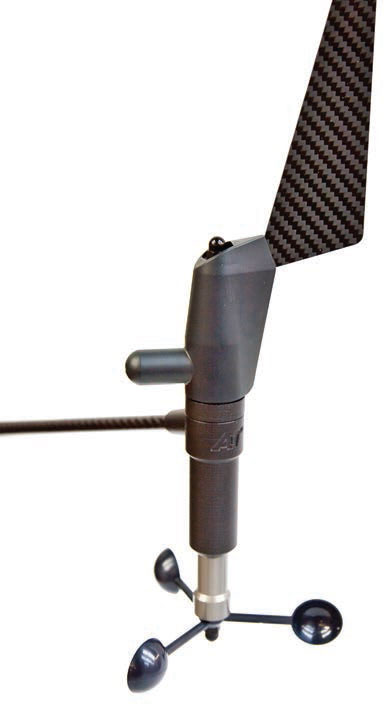
The new A+T fast response wind sensor is offered in three different versions including output of masthead motion.

The masthead is the most dynamically vigorous point on a sailing boat... without factoring that movement into your instruments all that wonderful masthead data will only ever be one part of the story
In the November edition of this magazine, the design features of the new A+T wind sensor were covered showing how it sets new standards of light weight, fast response time and robust construction.
Here we examine in more detail the interface options available and their applications including the revolutionary Inertial IMHU which measures mast head motion right at the wind sensor itself.
Traditional Analogue
The sensor outputs on the conventional six-core cable: speed as a pulse plus apparent wind direction as three analogue phases. This makes it a direct replacement for the many, many thousands of B&G 213 wind sensors which have been installed on yachts since the late 1980s and the instruments to which these are connected. It also satisfies many purist navigators and system designers who want the wind data in its rawest undamped format.
Instrument systems with which this is compatible include B&G H2000, H3000, H5000, WTP, FaRo, Sailmon and of course A+T.
Digital
It is also available with a digital output sending speed and wind angle at 20Hz in NMEA 0183HS (38,400 baud) of undamped data. This output option is aimed at the serious navigator or system builder who wants the fastest, highest quality wind data for their processor. This is also a flexible solution as it will interface to almost any modern instrument system.
The A+T masthead PCB turns any existing B&G wand into a digital version and is also a direct replacement for the B&G WS series PCB, offering undamped and faster data with added calibrated accuracy and repeatable zero setting.

The A+T masthead PCB with connectors for four-core (digital) and six-core mast cables
Recently Campbell Field used an A+T vertical wand with digital output interfaced to Raymarine Axiom instruments on board the Balance 526 catamaran Norhi while winning the Cape to Rio Race. He commented afterwards: ‘We managed to enhance a basic non-racing instrument system using Expedition software to give us good wind data which helped with steering and weather forecast interpretation’.
Another yacht using this configuration is Malizia sailing in The Ocean Race; they had previously been having problems with other sensors breaking with shock loads.
Inertial MHU
This is completely new as a production item, a wind sensor with a six-axis inertial sensor built into the masthead unit. This measures all the accelerations directly at the wind sensor itself, so a big leap forward for masthead motion correction first devised by Graeme Winn of Sailmath in the late 80s for the America’s Cup.
The masthead PCB measures the three linear accelerations and three rotational accelerations from rate gyros and sends this data together with the time stamped raw wind data at 50Hz. The data is sent as serial at 57,600 baud in a custom binary format. The instrument processor takes this information combined with hull movement measurements to derive masthead velocity and hence correct for mast motion. It is important to stress that no motion correction takes place in the sensor, just fast measurement of all the raw wind and inertial data.
Another application which became apparent while talking to a number of top skippers and navigators at METS last November is the measurement of actual masthead accelerations. Breaking of wands and sensors is a continuing challenge for ever higher performing boats, so this new sensor provides the raw data – at least until the point when it breaks! The 50Hz data rate allows peak loading to be recorded.
At the moment only A+T processors are providing the maths to deal with this sensor, but FaRo have the interface protocol and working units and will have this working for the coming sailing season. At least one of the TP52s is planning to go with this FaRo/A+T combination for 2023, along with some of the maxis.
The format of the data stream from the A+T IMHU sensor is open to any instrument manufacturer and it is hoped that other systems will soon provide the functionality to use this A+T IMHU sensor for masthead movement wind correction.
And finally, even better is that any A+T or B&G wind sensor can be converted to an IMHU by changing the masthead PCB to the A+T enhanced inertial version.
A+T has no affiliation or connection with B&G/Navico or any of the other manufacturers mentioned in this article.
Click here for more information on A+T Instruments »
We invite you to read on and find out for yourself why Seahorse is the most highly-rated source in the world for anyone who is serious about their racing.
To read on simply SIGN up NOW
Take advantage of our very best subscription offer or order a single copy of this issue of Seahorse.
Online at:
www.seahorse.co.uk/shop and use the code TECH20
Or for iPad simply download the Seahorse App at the iTunes store


